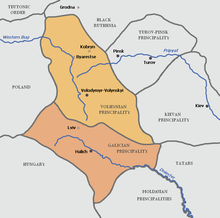Principality of Galicia-Volhynia
The Principality of Galicia-Volyn ( Old Russian Галицко-Волынскоє кънѧжьство , Ukrainian Галицько-Волинське князівство , Russian Галицко-Волынское княжество , Latin Regnum Galiciæ et Lodomeriæ ), and later Russian (Ruthe African) Kingdom ( Regnum Russiae ) was a successor principality of Kievan Rus , the in its greatest territorial extent included the present-day historical landscapes of Galicia , Volhynia , Podlachia , Polesia and Podolia . It was the westernmost and one of the most powerful Russian principalities between the late 12th century and the early 14th century . The principality was named after its main festivals, today's cities of Halych ( Galitsch ) and Wolodymyr ( Vladimir , Lodomeria ) and the Volhynia region. After the local Rurikid rulers died out, the principality was divided between Poland and Lithuania .
history
prehistory
At the end of the 10th century , the Tscherwener Burgenland became part of the Kievan Rus when Prince Vladimir I moved against Poland in 981 and this region joined his empire. In 987 he founded the Principality of Volhynia with the castle Wolodymyr-Wolynskyj . In the following years various smaller principalities split off ( Zvenigorod , Peremyschl , Terebovlja , Lutsk ). In 1124 the Principality of Galicia was formed.
In the 12th century, areas around Kiev were attacked by nomadic steppe peoples , such as the Polowzians . Subsequently, parts of the population migrated to the northeast of the empire ( Vladimir-Suzdal ) and to the northwest (Halych, Wolodymyr), which promoted the economic and political rise of these areas.
Principality of Galicia-Volhynia
The Principality of Galicia-Volhynia was founded in 1199 by the Rurikid Prince Roman through the merger of the Principality of Galicia and Volhynia . It subsequently developed into one of the most powerful successors of the Kievan Rus.
However, it suffered severe devastation due to the Mongol invasion in 1240 and was forced to recognize the supremacy of the Golden Horde in 1245.
In the course of the 14th century the principality became an object of contention for its neighbors, including Hungary. In 1323 the ruling Rurikid dynasty of the Principality of Galicia-Volhynia died out in the male line. The nephew of the last prince, Juri II, Bolesław of Mazovia , became ruler of the Principality of Galicia-Volhynia. He was related to both the Polish and the Lithuanian ruling family. However, when Juri-Bolesław was poisoned by his boyars in 1340 for allegedly preferring Catholics , a battle broke out between the emerging Eastern European powers Poland and Lithuania over the inheritance of the Principality of Galicia-Volhynia.
After longer wars with mutual gains and losses, the greater part of the principality with Galicia and western Volhynia fell to the Kingdom of Poland, while eastern Volhynia, Podolia, Podlachia and Polesia were annexed to the Grand Duchy of Lithuania in the long term . The Hungarian claim, asserted by his intervention since the beginning of the 13th century, was continued in the royal statute there, the name " Galicia and Lodomeria " with which the House of Habsburg-Lorraine, in its capacity as kings of Hungary, designated their Polish division much later , is derived from it.
Through the Union of Lublin in 1569, the entire area of the former Principality of Galicia-Volhynia was connected to the "Crown of Poland", but it no longer existed as a political unit within the original borders. The area was administratively divided into five voivodships , which belonged to Poland-Lithuania until the partitions of Poland in the years 1772 to 1795 .
From 1772/1795, Polish rule was followed by that of the Austrian and Russian empires .
in the 13th century
FGW (years)
between
sub-principalities
trade routes
Ruthenian
principalities
Princes and Kings of Galicia-Volhynia
In the list only those rulers are mentioned by name who completely ruled the principality or at least owned one of the principalities, but who claimed the entire empire in their titles.
Rurikids
| Surname | from | to | Remarks |
|---|---|---|---|
| Novel I. | 1199 | 1205 | Prince of Volhynia and Galicia |
Arpad
| Surname | from | to | Remarks |
|---|---|---|---|
| Koloman of Galicia | 1215 | 1221 | only in Galicia as the "king" of Galiciæ et Lodomeriæ , son of Andrew of Hungary, overthrown in 1216, reinstated in 1219, abdicated in 1221 |
| Andrew of Galicia | 1228 | 1234 | only in Galicia as "King" of Galiciæ et Lodomeriæ , son of Andreas of Hungary |
Rurikids
| Surname | from | to | Remarks |
|---|---|---|---|
| Daniel Romanowitsch of Galicia | 1238 | 1264 | from 1229 Prince of Volhynia, from 1238 in Galicia, from 1253 Rex Rusiae ("King of Russia") |
| Leo I of Galicia | 1264 | 1301 | from 1264 Prince of Galicia, from 1269 Rex Rusiae (“King of Russia”), from 1293 Prince of Volhynia |
| Yuri I. | 1301 | 1308 | from 1301 King of Galicia-Volhynia |
| Lev II | 1308 | 1323 | from 1308 together with his brother Andreas as kings of Galicia-Volhynia. Both died in a battle against Lithuania in Podlachia in 1323. |
Piasts
| Surname | from | to |
|---|---|---|
| Jurij II., Boleslaw of Mazovia | 1323 | 1340 |
| Casimir of Poland | 1340 | 1370 |
| Wladislaus II of Opole | 1372 | 1378 |
Hungarian branch of the Anjou
| Surname | from | to |
|---|---|---|
| Ludwig I. | 1370 | 1382 |
| Maria of Anjou | 1382 | 1387 |
| Hedwig of Anjou | 1387 | 1399 |




